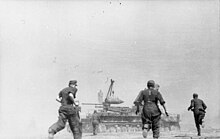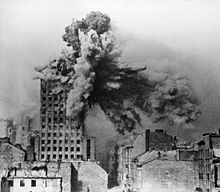Karl-Gerät
Each gun had to be accompanied by a crane, a two-piece heavy transport set of railcars, and several modified tanks to carry shells.
In March 1936 Rheinmetall made a proposal for a super-heavy howitzer to attack the Maginot Line.
Extensive driving trials took place in 1938 and 1939 using the first Neubaufahrzeug tank prototype and a scale model to investigate the extremely high ground pressure and steering of such an enormous vehicle.
General Karl Becker of the Artillery was involved in the development, from whom the huge weapon gained its nickname.
The first six had the nicknames "Adam" (later "Baldur"), "Eva" (later "Wotan"), "Thor", "Odin", "Loki", and "Ziu"; the seventh, the research and test weapon (Versuchs-Gerät), had no name.
[3] In February 1941, discussions commenced concerning increasing the range of the weapon, and in May 1942, 54 cm (21 in) Gerät 041 barrels were ordered for the six vehicles.
At a conference with Adolf Hitler in March 1943 it was stated that the first Gerät 041 would be delivered by June 1943, and the third by mid-August.
D, E and F chassis were modified, with a superstructure capable of carrying four shells that replaced the turret, and outfitted with a crane as Munitionsschlepper für Karl-Gerät ammunition transporters/loaders.
[6] The weapon was moved long distances via rail on a variant of a Schnabel car; the whole chassis was hung between two huge pedestal-mounted swiveling arms fixed to five-axle bogies.
[7] When it reached its destination, the weapon was detached from railcars' supporting arms and driven to its intended firing location.
The chassis of the ordnance was then lowered to the ground by "raising" the continuous track units' roadwheels by rotating their torsion-bar-sprung suspension arms to drop the chassis close to the ground to distribute the recoil forces more evenly in preparation for firing - the roadwheels for each trackset were also similarly "raised" to allow the tracks to clear the rails while being transported by rail, between the pair of Schnabel railcars.
[7] The various Karl-Geräte used two different types of transmissions, engines and suspension system in a bewildering set of combinations.
[13] In preparation for the attack on Sevastopol scheduled for the early summer Heavy Artillery Battalion 833 was ordered to form a Karl-Batterie with three weapons on 18 February 1942, two of which were "Thor" and "Odin".
On 20 May 1942 the 11th Army reported all three Karl-Geräte were at the front with a total of 72 heavy and 50 light concrete-piercing shells.
They did rather more damage to the concrete structure supporting the turrets as well as the command center located some 600 metres (2,000 ft) away (called the Bastion by the Germans).
This was done by 15 August as schwere Batterie 628 (Karl) with two weapons, although sufficient personnel to man three guns was to be furnished by Heavy Artillery Battalion 833.
On 22 July the Army High Command (Oberkommando des Heeres (OKH)) issued an order to send the battery to Army Group North to support its planned offensive, Operation George (Unternehmen Georg), against Leningrad.
Army Group North reported the battery's arrival on 1 and 2 September 1942, but the Soviets preempted Georg with heavy attacks against the German forces besieging Leningrad so the Karl-Geräte didn't get into action.
Just like the 833rd the battalion was ordered to reform with eight 21 cm (8.3 in) Mörser 18 howitzers on 29 August 1943 with effect by 10 September.
This was redesignated Unit for Special-Equipment of Heavy Artillery Battalion (motorized) (Kommando für Sonder-Gerät des schwere Artillerie-Abteilung (mot.))
[16] On 13 August 1944 a battery was ordered to be created immediately with one 54 cm (21 in) Karl-Gerät and sent to the 9th Army to help it suppress the Warsaw Uprising.
On 18 August 1944 a shell fired from mortar "Ziu" hit the building at Moniuszki 10 street, where the famous Warsaw restaurant "Adria" was located.
The shell broke through several stories of the building, roof and floor of the restaurant and finally stopped in the basement, but it did not explode.
Sappers of Polish Home Army disarmed the dud shell and removed the explosive charge.
[18] The most recent one was found on 28 August 2012 about 10 m (30 ft) below surface of the ground in the neighborhood of Plac Powstańców Warszawy during construction of the second metro line in Warsaw.
A second battery, numbered 428, was formed two days later by the Kommando für Sonder-Geräte, but it did not arrive at the Warsaw West railway station until 12:57 on 7 September 1944.
[17] A meeting was held on 29 September by the OKH General der Artillerie to discuss the overall status of the Karl-Gerät, its supporting equipment and ammunition:[24] Three days later Battery 638 was ordered to transfer to Budapest and was loaded without any Karl-Gerät.
II and VI (both with Gerät 040) and departed for the West on 14 December 1944 to participate in Operation Watch on the Rhine (Unternehmen Wacht am Rhein), which would be known by Americans as the Battle of the Bulge, but didn't reach the front until 29 December.
Karl-Batterie 638 arrived on 20 March, but after only 14 rounds that missed all of the bridges and only damaged a handful of random houses, the weapon had to be moved to the rear for repairs.
VII, the test weapon, was captured by the US Army in Hillersleben and shipped to Aberdeen Proving Grounds but later scrapped.






